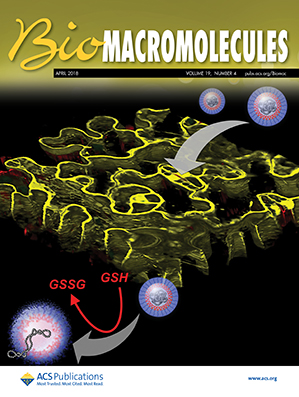Biomimetic Chitosan Nanogels Codeliver Drug/Small Activating RNA for Metastasis-Inhibited Necroptosis Therapy of Ovarian Cancer
IF 5.4
2区 化学
Q1 BIOCHEMISTRY & MOLECULAR BIOLOGY
引用次数: 0
Abstract
Ovarian cancer remains the leading cause of gynecologic malignancy-related deaths. Developing novel nanoplatforms to overcome the low efficacy of chemotherapy and advanced metastasis in ovarian cancer is crucial. Here, we report biomimetic chitosan nanogels (CH NGs) designed to codeliver gambogic acid (GA) and MAS1 small activating RNA (saMAS1). The formed CH NGs/GA/saMAS1 camouflaged with ovarian cancer cell membranes (CM) can release GA in a pH-responsive manner, target cancer cells, and induce the killing effects through GA-mediated necroptosis. Meanwhile, saMAS1 upregulates MAS1 expression, counteracting the activation of angiotensin II receptor type 1 (AGTR1) and thereby inhibiting the renin-angiotensin system (RAS) signaling pathway, subsequently impeding metastasis. The therapeutic efficacy of CH NGs/GA/saMAS1@CM NGs regarding primary tumor killing and metastasis inhibition was further confirmed using ovarian mouse models. These biocompatible CH NGs represent a promising advanced nanomedicine formulation to tackle ovarian cancer through metastasis-inhibited necroptosis following the codelivery of GA and saMAS1.
- Download: Download high-res image (283KB)
- Download: Download full-size image
仿生壳聚糖纳米凝胶协同递送药物/小激活RNA用于卵巢癌转移抑制坏死坏死治疗。
卵巢癌仍然是妇科恶性肿瘤相关死亡的主要原因。开发新的纳米平台来克服化疗的低疗效和卵巢癌的晚期转移是至关重要的。在这里,我们报道了仿生壳聚糖纳米凝胶(CH NGs)设计用于共同递送藤黄酸(GA)和MAS1小激活RNA (saMAS1)。形成的CH NGs/GA/saMAS1被卵巢癌细胞膜(CM)伪装,以ph响应的方式释放GA,靶向癌细胞,并通过GA介导的坏死坏死诱导杀伤作用。同时,saMAS1上调MAS1表达,抑制血管紧张素II受体1型(angiotensin II receptor type 1, AGTR1)的激活,从而抑制肾素-血管紧张素系统(renin-angiotensin system, RAS)信号通路,阻碍转移。通过卵巢小鼠模型进一步证实了CH NGs/GA/saMAS1@CM NGs对原发肿瘤的杀伤和转移抑制作用。这些具有生物相容性的CH NGs代表了一种有前途的先进纳米药物配方,可以通过GA和saMAS1共同递送后的转移抑制坏死性死亡来治疗卵巢癌。
本文章由计算机程序翻译,如有差异,请以英文原文为准。
求助全文
约1分钟内获得全文
求助全文
来源期刊

Biomacromolecules
化学-高分子科学
CiteScore
10.60
自引率
4.80%
发文量
417
审稿时长
1.6 months
期刊介绍:
Biomacromolecules is a leading forum for the dissemination of cutting-edge research at the interface of polymer science and biology. Submissions to Biomacromolecules should contain strong elements of innovation in terms of macromolecular design, synthesis and characterization, or in the application of polymer materials to biology and medicine.
Topics covered by Biomacromolecules include, but are not exclusively limited to: sustainable polymers, polymers based on natural and renewable resources, degradable polymers, polymer conjugates, polymeric drugs, polymers in biocatalysis, biomacromolecular assembly, biomimetic polymers, polymer-biomineral hybrids, biomimetic-polymer processing, polymer recycling, bioactive polymer surfaces, original polymer design for biomedical applications such as immunotherapy, drug delivery, gene delivery, antimicrobial applications, diagnostic imaging and biosensing, polymers in tissue engineering and regenerative medicine, polymeric scaffolds and hydrogels for cell culture and delivery.
 求助内容:
求助内容: 应助结果提醒方式:
应助结果提醒方式:


